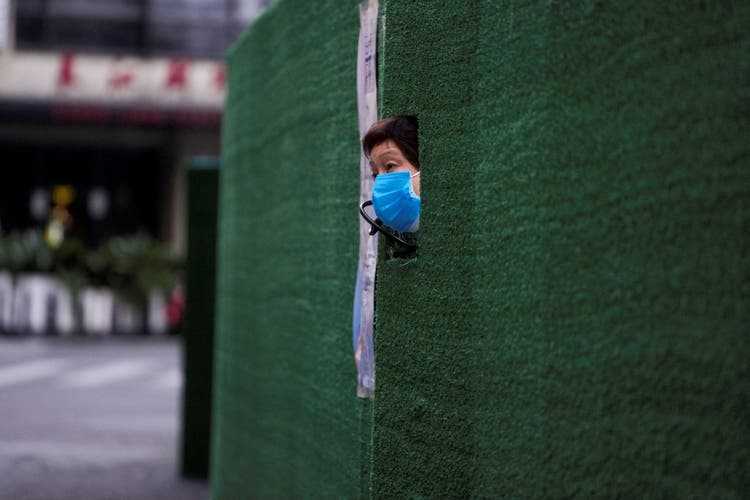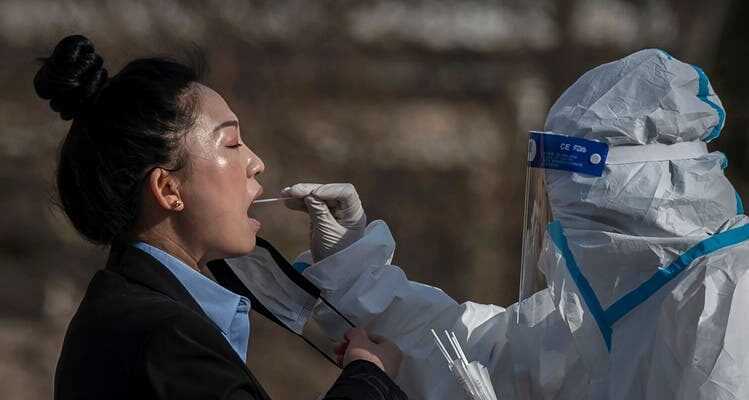The Chinese zero-Covid strategy hardly works against the highly infectious omicron variant. However, according to a model, important prerequisites for an immediate softening are missing.
In China’s cities, millions of people are tested for Sars-CoV-2 every day.
First Shanghai, now Beijing and many other megacities too: Because of omicron infections, the number of regions in China with very tough lockdowns and desperate residents is growing. But: “Without any containment measures, an omicron wave would rush through China like a tsunami,” predict researchers at Fudan University in Shanghai. They have a modeling in the trade journal on Tuesday «Nature Medicine» published, which depicts a frightening scenario in the event that all measures are now lifted. China would experience a pandemic in fast motion.
15-fold overloaded intensive care capacities
According to the calculations, there would be 112.2 million symptomatic infections, 2.7 million intensive care patients and 1.6 million corona deaths in the next six months. Statistically, that would be 1.1 deaths per thousand inhabitants. China would then have a balance sheet similar to that of many other countries. For comparison: over the entire pandemic, 1.7 people per thousand inhabitants died in Germany and 1.6 in Switzerland from and with Corona.
For China, however, the biggest problem is not the numbers themselves, but the fact that this large number of infected people and hospital patients would occur within a few weeks. According to the Shanghai researchers’ modelling, between May and July, when the peak of an unabated omicron wave is expected, intensive care unit capacities are about 15 times overstretched. Therefore, it could be that many people without a Sars-CoV-2 infection die from a lack of care.
This dramatic situation of an unchecked omicron wave will occur in China despite the fact that almost 90 percent of the population has now been fully vaccinated and around 40 percent have been boosted, the authors emphasize. On the one hand, the Chinese vaccines used could not prevent severe Covid 19 disease as effectively as the modern mRNA vaccines used in this country.
On the other hand, 52 million and thus far too many older people are not fully vaccinated. Consequently, 90 percent of the expected infected people who would need an intensive care bed in an unchecked omicron wave would be older than 60 years.
Rapid vaccination of all older people and the delivery of Covid 19 medication to all infected people would significantly reduce the number of hospital patients. However, according to the modelling, even that would not be enough to reduce the overload on the healthcare system to such an extent that an unchecked omicron wave would be medically manageable.
Still no vaccination campaign for the elderly
In addition, the reduction in the calculated extent through vaccinations and medication is primarily a wish. Firstly, there is currently no indication that the Chinese government will soon start a nationwide vaccination campaign for the elderly. Secondly, there would always be a problem with the availability of the desired medication. Many countries have already ordered large contingents of one drug, Paxlovid from the American company Pfizer. It is therefore more than questionable whether China will even receive the millions of packs it needs in the next few weeks.
The conclusion of the authors is therefore not surprising: Omicron can only be controlled in China if there are still several stringent containment measures such as school, office and factory closures, social distancing, bans on larger events and more. In other words: lockdowns.
However, the researchers do not comment on whether they would have to be as drastic as is currently being done in many places. Non-Chinese experts have been pointing out for a long time that hospital capacities could be used in a more targeted and resource-saving manner if the management of those infected with the corona virus focused less on hospital admissions.

A resident looks through a barrier in her apartment block in Shanghai. Food is served through the hatches.
It is of course conceivable that the authors, several of whom work in a university department belonging to the Ministry of Education in Shanghai, have submitted a commissioned study, so to speak, that provides the scientific basis for the government’s rigid adherence to the zero-Covid strategy target. But it would be astonishing if something like this would appear in the renowned journal “Nature Medicine”, which belongs to a German publishing group, after external assessment by experts.
China’s anti-corona strategy is hopeless at Omikron
The new study impressively demonstrates the fatal dead end into which the Chinese government and President Xi have maneuvered themselves and the whole country by sticking to the zero-Covid strategy, rejecting foreign vaccines and neglecting targeted vaccinations of older people. Omicron spreads so rapidly that it cannot be eradicated with rigorous testing and isolation. The economic as well as the psychological and physical damage to the Chinese population is already immense as a result of the lockdowns.
And there is no easy way out. Because the softening will cost many lives. As did the earlier waves in Europe and elsewhere. And the government fears that. Because this development caused the message that China is superior to the West because President Xi had devised the better anti-corona strategy and can therefore protect its population better, to collapse like a house of cards.
